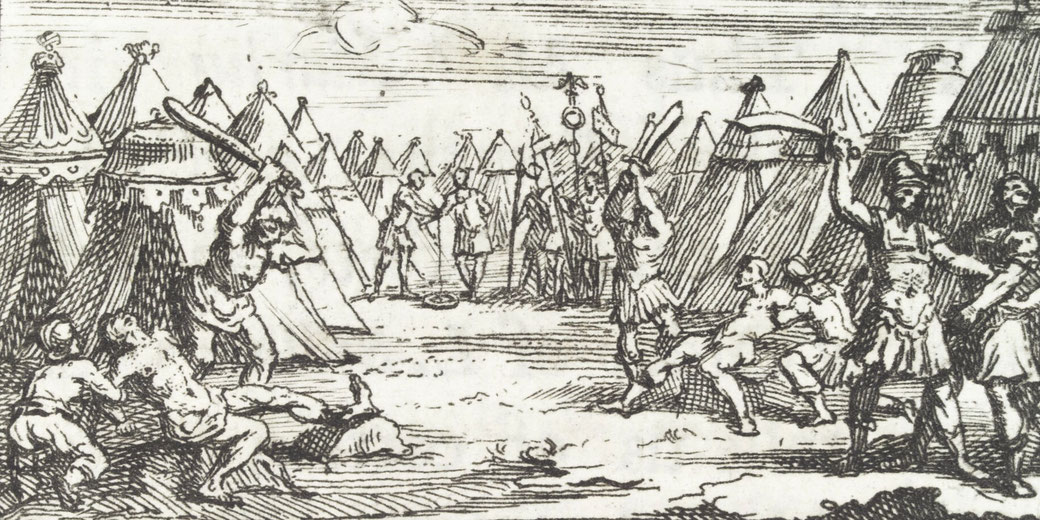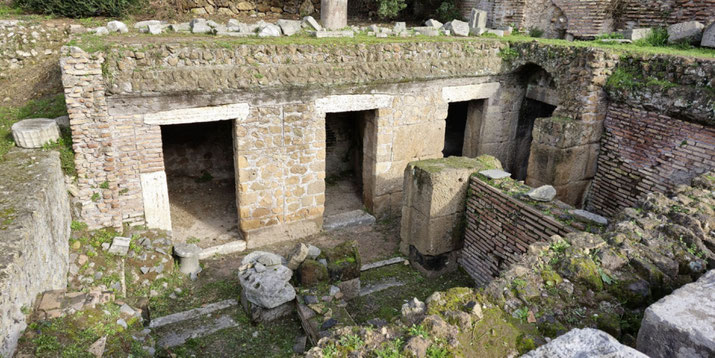How Roman slaves escaped their masters and the horrifying punishments they received if caught

Ancient Rome was a society where the concept of personal freedom had a significantly different meaning than it does in modern times.
At the height of the Roman Empire, slaves comprised approximately 40% of the total population, an astonishing figure that sheds light on the profound implications of the slavery system on Roman society.
What were the harsh realities faced by these slaves, especially those who dared to escape their masters?
And what were the repercussions when they were captured?
How did people become slaves in Ancient Rome?
In Ancient Rome, there were several primary ways in which people could become enslaved.
Here are the most common circumstances:
Conquest in War
This was by far the most common way in which people became slaves in the Roman Empire.
Rome was a militaristic society that waged many wars and frequently enslaved those they defeated.
These newly captured slaves would then be brought back to Rome and sold at public auctions.
Birth
Children of slaves, known as "vernae," were considered slaves themselves. This fact of life was a harsh reality for countless generations born into servitude, perpetuating the cycle of slavery within the Empire.
Piracy and Kidnapping
Pirates operating in the Mediterranean sometimes captured individuals to sell into slavery.
Similarly, kidnapping was another method, albeit less common, of acquiring slaves. Criminal gangs within the Empire were known to kidnap both Romans and non-Romans to sell them into slavery.
Debt
In earlier periods of Roman history, a free Roman citizen could become a slave, or "nexus," as a result of unpaid debts.
The debtor would be obliged to serve their creditor as a slave until the debt was repaid.
This practice, however, was abolished in 326 BC with the passing of the Lex Poetelia Papiria law.
Crime and Punishment
Certain crimes could result in a free person being enslaved as a form of punishment.
In these cases, the state would sell the person into slavery, with the proceeds usually going to the state treasury.
Abandonment
In Ancient Rome, it was not uncommon for unwanted babies to be abandoned, typically at a dump outside the city or in the countryside.
These infants could be collected and raised to become slaves.
What methods did slaves use to escape?
Escaping from the clutches of slavery was no simple task. Slaves often had few resources at their disposal and faced severe punishment if their escape attempts failed.
There were, however, several common methods slaves used in their attempts to flee their servitude.
Flight was the most direct and common method. Slaves would seize the opportunity when they were unsupervised or exploit gaps in their masters' defenses.
These instances often involved immense risk, as they required crossing vast, open territories, usually without any substantial provisions.
Many slaves tried to blend into the free population, seeking to lose themselves in the urban landscapes of Rome or other large cities.
Another common way for slaves to gain their freedom was manumission, which was the act of a master freeing a slave.
This could be done for a variety of reasons, such as a reward for loyal service, as part of the master’s will, or occasionally, slaves could even purchase their freedom if they were allowed to keep some earnings.
However, the freedom gained this way was not equal to that of a freeborn Roman, and they were often obliged to provide certain services to their former masters.
Alternatively, some underground networks did exist to support escapees. While not as organized as the Underground Railroad of 19th-century America, there were informal networks that helped slaves escape their masters.
These networks were composed of other slaves, freedmen, and occasionally sympathetic free Romans, who provided information, food, shelter, and sometimes, transportation.
Where did slaves try to escape to?
The places Roman slaves sought to escape to varied widely based on their circumstances, such as their location within the empire, their knowledge of the surrounding area, and the opportunities they perceived.
Many runaway slaves tried to disappear in the dense populations of Rome and other large cities, hoping to blend in with the free population and avoid detection.
Others escaped to more remote, less populated areas, such as the mountains or forests.
These environments could offer hiding places and reduced risk of capture, even if they also posed challenges for survival.

Some slaves might try to reach seaports with the aim of finding passage to a more distant place where they would be less likely to be recognized and recaptured.
There were instances where runaway slaves formed their own communities in less accessible regions.
For example, in Sicily during the First and Second Servile Wars, escaped slaves established their own armed communities.
On rare occasions, and if geographically feasible, a slave might attempt to flee to territories outside the Roman Empire, where Roman law didn't apply and the chances of being returned to their masters would be lower.
In some cases, slaves might seek sanctuary in temples or other religious sites where they might be protected by religious laws and traditions.
It's important to remember that escaping from slavery was a dangerous and often desperate act, and the fugitives would have had to face numerous hardships and risks, including hunger, exposure, and the constant threat of capture.
Despite this, many chose to risk these perils in the hope of gaining their freedom.
How did Ancient Romans try to find run-away slaves?
Roman slave owners employed various methods to track and recapture runaway slaves, an action they deemed essential to maintain the existing social order and deter other slaves from escaping.
They could employed professional slave hunters, known as "fugitivarii" or "servile quaestores."
These individuals were often former slaves themselves, well acquainted with the hardships of the servile life and the desperate strategies employed by fugitives.
Armed with a deep understanding of human behavior and specialized tracking skills, they were highly effective at locating and capturing runaway slaves.
Slave owners often posted public notices about their escaped slaves. These descriptions included physical attributes, any distinguishing features or marks, and sometimes, information about the skills that the slave possessed.
A reward was often offered for the capture and return of the runaway slave.
Some slaves wore metal collars around their necks that bore inscriptions revealing their owner's name and address.
These collars, while oppressive, provided immediate identification if the slave was caught.
Some inscriptions even offered a reward to anyone who returned the slave to their master.
Also, Roman law offered legal protection and incentives to those who captured and returned runaway slaves.
Anyone harboring a fugitive could face severe penalties, creating an environment where the majority of the populace became unwilling or unable to assist runaways.
Finally, the local community often became involved in the search for escaped slaves.
Neighbors, fellow slaves, or anyone who might have information were questioned. Fear of punishment or the prospect of a reward could lead many to provide valuable information.
How were slaves punished if they were recaptured?
If captured, runaway slaves in Ancient Rome faced severe and brutal repercussions, which served not only as a punishment but also as a deterrent for other slaves who might contemplate escape.
Physical Punishment
This was common and could include flogging, whipping, or branding. A common practice was to brand the forehead of the fugitive with the letter 'F' for 'fugitivus' (runaway), a permanent and visible mark of their attempt to escape.
Ergastulum
This was a Roman private prison specifically for slaves, where they were kept in chains and forced to work.
The conditions were extremely harsh, with minimal light and ventilation. It was a form of psychological punishment that aimed to break the spirit of the slave.
Increased Workloads and Degraded Roles
Some recaptured slaves were assigned more strenuous work or placed in demeaning roles as a form of punishment.
For example, they could be sent to work in the fields or mines, known for their brutal conditions, or in public facilities doing menial tasks.
Sale to Gladiatorial Schools
In some instances, the slaves were sold to become gladiators. This was a harsh and often short-lived fate due to the brutal and violent nature of gladiatorial contests.
Death
The ultimate punishment was execution, typically by crucifixion. This was often reserved for slaves who had repeatedly run away or were deemed particularly troublesome.
Amputation
In rare and extreme cases, to prevent further attempts to escape, parts of the feet or the legs of the runaway slave were amputated.
Unfortunately, the intensity of the punishment often depended on the slave’s previous behavior, the mood and temperament of the master, and whether the slave had committed other offenses while on the run.
Famous escaped slaves from Roman history
Spartacus
Perhaps the most famous runaway slave in Roman history, Spartacus was a Thracian who was sold into slavery and trained at a gladiatorial school in Capua.
In 73 BC, he led an uprising, often referred to as the Third Servile War, along with two Gallic slaves, Crixus and Oenomaus.
They escaped the school along with about 70 other gladiators, and their numbers quickly grew to an army of tens of thousands.
Despite achieving some initial victories against the Roman military, Spartacus and his rebel force were eventually defeated by the Roman general Crassus in 71 BC.
Epictetus
Although he did not run away, Epictetus was born a slave and later gained his freedom.
He became one of the most influential Stoic philosophers. His teachings, recorded by his pupil Arrian, emphasized personal freedom and ethical conduct, and they continue to be influential today.
Onesimus
Onesimus was a slave to Philemon, an early Christian in Asia Minor. He ran away and eventually encountered the apostle Paul in Rome.
Paul converted him to Christianity and sent him back to Philemon with the Epistle to Philemon, a letter that asked for Onesimus to be received "no longer as a slave but more than a slave, a beloved brother."
What do you need help with?
Download ready-to-use digital learning resources
Copyright © History Skills 2014-2025.
Contact via email
With the exception of links to external sites, some historical sources and extracts from specific publications, all content on this website is copyrighted by History Skills. This content may not be copied, republished or redistributed without written permission from the website creator. Please use the Contact page to obtain relevant permission.





